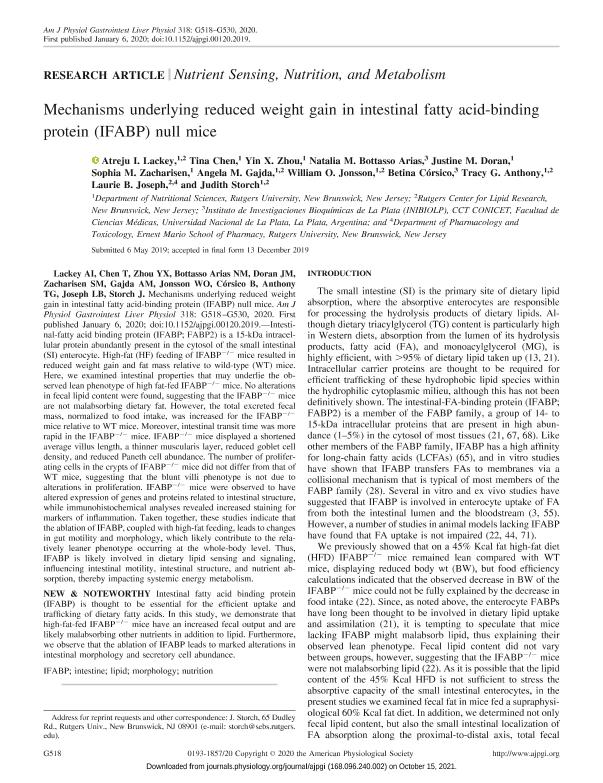Artículo
Mechanisms underlying reduced weight gain in intestinal fatty acid-binding protein (IFABP) null mice
Lackey, Atreju I.; Chen, Tina; Zhou, Yin X.; Bottasso Arias, Natalia María ; Doran, Justine M.; Zacharisen, Sophia M.; Gajda, Angela M.; Jonsson, William O.; Córsico, Betina
; Doran, Justine M.; Zacharisen, Sophia M.; Gajda, Angela M.; Jonsson, William O.; Córsico, Betina ; Anthony, Tracy G.; Joseph, Laurie B.; Storch, Judith
; Anthony, Tracy G.; Joseph, Laurie B.; Storch, Judith
 ; Doran, Justine M.; Zacharisen, Sophia M.; Gajda, Angela M.; Jonsson, William O.; Córsico, Betina
; Doran, Justine M.; Zacharisen, Sophia M.; Gajda, Angela M.; Jonsson, William O.; Córsico, Betina ; Anthony, Tracy G.; Joseph, Laurie B.; Storch, Judith
; Anthony, Tracy G.; Joseph, Laurie B.; Storch, Judith
Fecha de publicación:
27/02/2020
Editorial:
American Physiological Society
Revista:
American Journal of Physiology-gastrointestinal and Liver Physiology
ISSN:
0193-1857
e-ISSN:
1522-1547
Idioma:
Inglés
Tipo de recurso:
Artículo publicado
Clasificación temática:
Resumen
Intestinal- fatty acid binding protein (IFABP; FABP2) is a 15-kDa intracellular protein abundantly present in the cytosol of the small intestinal (SI) enterocyte. High-fat (HF) feeding of IFABP-/- mice resulted in reduced weight gain and fat mass relative to wild-type (WT) mice. Here, we examined intestinal properties that may underlie the observed lean phenotype of high fat-fed IFABP-/- mice. No alterations in fecal lipid content were found, suggesting that the IFABP-/- mice are not malabsorbing dietary fat. However, the total excreted fecal mass, normalized to food intake, was increased for the IFABP-/- mice relative to WT mice. Moreover, intestinal transit time was more rapid in the IFABP-/- mice. IFABP-/- mice displayed a shortened average villus length, a thinner muscularis layer, reduced goblet cell density, and reduced Paneth cell abundance. The number of proliferating cells in the crypts of IFABP-/- mice did not differ from that of WT mice, suggesting that the blunt villi phenotype is not due to alterations in proliferation. IFABP-/- mice were observed to have altered expression of genes and proteins related to intestinal structure, while immunohistochemical analyses revealed increased staining for markers of inflammation. Taken together, these studies indicate that the ablation of IFABP, coupled with high-fat feeding, leads to changes in gut motility and morphology, which likely contribute to the relatively leaner phenotype occurring at the whole-body level. Thus, IFABP is likely involved in dietary lipid sensing and signaling, influencing intestinal motility, intestinal structure, and nutrient absorption, thereby impacting systemic energy metabolism.
Palabras clave:
IFABP
,
INTESTINE
,
LIPID
,
MORPHOLOGY
,
NUTRITION
Archivos asociados
Licencia
Identificadores
Colecciones
Articulos(INIBIOLP)
Articulos de INST.DE INVEST.BIOQUIMICAS DE LA PLATA
Articulos de INST.DE INVEST.BIOQUIMICAS DE LA PLATA
Citación
Lackey, Atreju I.; Chen, Tina; Zhou, Yin X.; Bottasso Arias, Natalia María; Doran, Justine M.; et al.; Mechanisms underlying reduced weight gain in intestinal fatty acid-binding protein (IFABP) null mice; American Physiological Society; American Journal of Physiology-gastrointestinal and Liver Physiology; 318; 3; 27-2-2020; G518-G530
Compartir
Altmétricas



